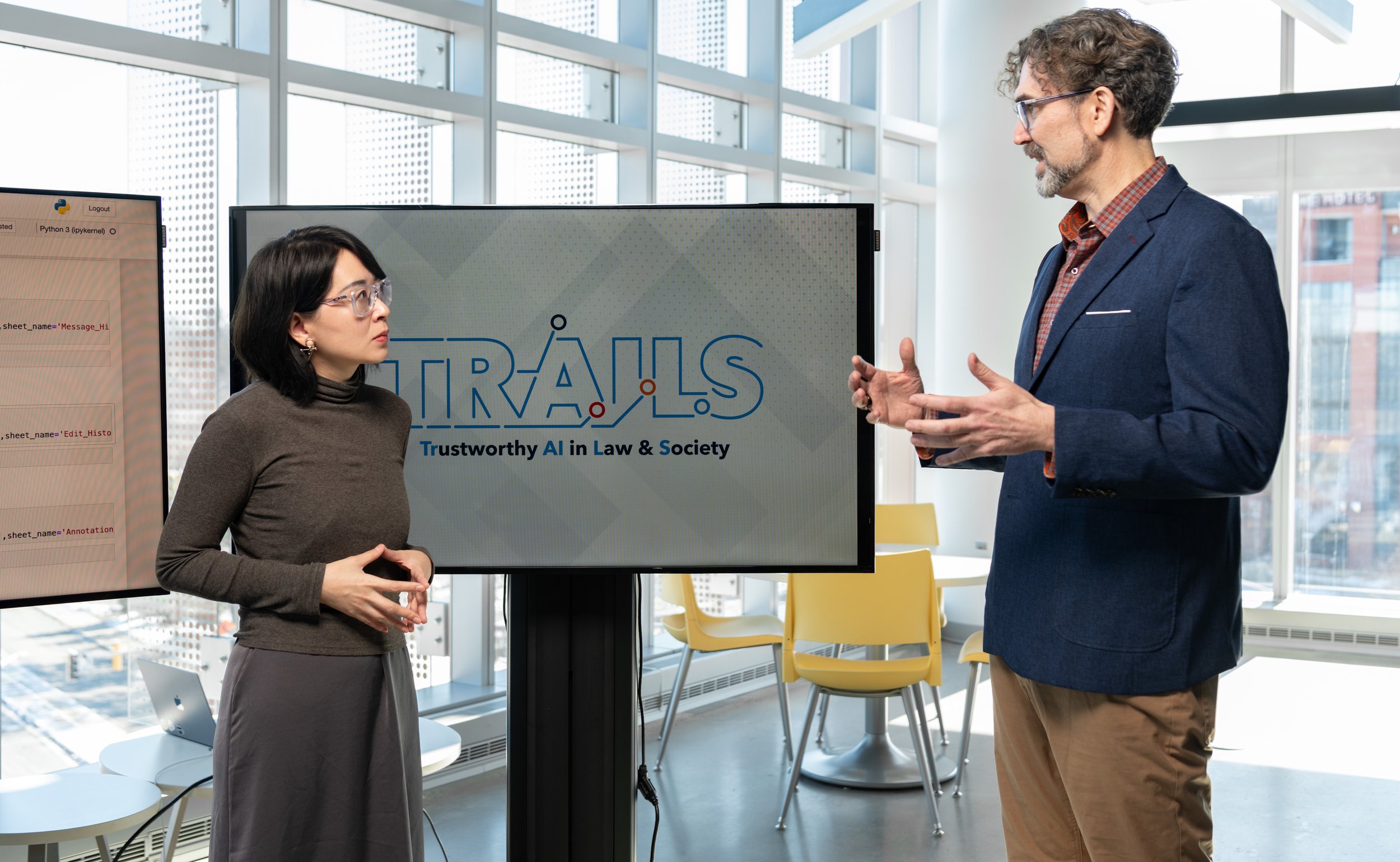
Associate Professor of Higher Education and Student Affairs
Virginia Byrne, Co-PI
Morgan State University Site Lead
Areas of Expertise: Social Media, Trauma and Design
Virginia Byrne is an associate professor of higher education & student affairs at Morgan State University. Her research focuses on climate and equity in online and technology-enhanced learning environments. More specifically, Byrne’s work investigates how social media and instructional technology are changing how we teach, learn and connect in higher education. As a co-PI of TRAILS, Byrne leads community-driven projects related to the interplay between AI and education.
-
Byrne, V. L. (2021a). Blocking and Self-Silencing: Undergraduate Students’ Cyberbullying Victimization and Coping Strategies. TechTrends: Linking Research & Practice to Improve Learning, 65(2), 164–173.
Abstract: Cyberbullying is an emerging equity issue in American higher education with well-documented social, psychological, and academic consequences. Unfortunately, while higher education leaders are grappling with how to respond to cyberbullying victimization among students, their efforts are hindered by the lack of consensus on how to measure victimization or what support strategies to provide. The purpose of this paper is to explore the cyberbullying experiences of a diverse sample of undergraduate students. Using a validated measure of victimization among a sample of 459 undergraduates at a research university in the American Mid-Atlantic, nearly three out of five respondents reported having been previously victimized by a cyberbully. While universities have a duty to support victims and provide a learning environment free from harassment, this study found that students do not turn to their campus faculty and staff for support. Instead college student victims adopt technical coping strategies (e.g., block the bully, adjust privacy settings) which may further isolate them from their online communities and entrusts social media companies to resolve the situation. Contributions poses the connection between coping strategies and self-censoring in online courses.
-
Byrne, V. L. (2021b). “You Might As Well Just All Agree With Each Other:” An Initial Study Of Cyberbullying Victims’ Social Presence In Online Discussions. Computers & Education, 167, 104174.
Abstract: Cyberbullying affects the majority of undergraduate women, contributing to withdrawal from social media and chilling their participation in the growing world of collaborative online discussions. This pilot mixed-methods study integrates surveys, observations, and interviews of nine undergraduate women at a Mid-Atlantic research university to investigate how the chilling effect of cyberbullying may extend into peer interactions within an increasingly common online instructional practice: online discussion boards. It is observed that, in comparison to their nonvictimized peers, participating women with prior cyberbullying experiences enact lower social presence and adopt self-silencing and conflict avoidant coping strategies. In particular, these women avoid ever disagreeing with peers out of fear of starting “drama.” Findings challenge educators to consider the potential unintended consequences of instructional design choices and contributes to our understanding of how to design more equitable online learning environments for today’s socially networked learners.
-
Byrne, V. L., & Diaz-Espinoza, C. (2022). Introduction to the Special Issue: Critical Perspective on Online Trauma. Journal of Trauma Studies in Education, 1(2), Article 2.
Excerpt: The role of technology in higher education has rapidly evolved, even prior to the onset of the COVID-19 pandemic and racial justice reckoning of 2020. Since these events, the call for increased access to digital learning has markedly increased. We propose that the conversation must shift from debating the benefits of technology to how higher education will utilize technology to empower those who are part of its culture. While technology is an inevitable part of the future of higher education, online trauma is not and should not be accepted as such. Common examples of online trauma may include cyberbullying and online harassment, being excessively exposed to hateful and harmful content, or viewing violent media of police brutality. The research and practical perspectives within this issue challenge the thinking that online spaces are simply environments in which students, faculty, and staff are consumers and not creators. The authors present data and ideas which can help administrators intentionally consider online spaces as opportunities for students and faculty of marginalized identity groups to co-create conditions in which their voices are amplified and they are allowed to thrive in ways that in-person environments have not historically offered.
-
Byrne, V. L., Higginbotham, B. L., Donlan, A. E., & Stewart, T. J. (2021). An Online Occupation of the University Hashtag: Exploring How Student Activists Use Social Media to Engage in Protest. Journal of College and Character, 22(1), 13–30.
Abstract: Today’s student activists leverage social media to bring campus-based protests to a wider audience and create a counterspace for discussing racism on campus. In this article, the authors present a novel case of social media activism in which students occupied an official university hashtag to raise awareness of racism on campus (i.e., an online occupation). The authors examined 776 tweets posted after a fatal hate crime to understand how student activists organized the occupation of the institutional hashtag and how students, faculty, alumni, and the media participated in the movement. Findings shed light on the potential disruptive power of social media activism.
-
Byrne, V. L., & Hollingsworth, J. (2021). An Initial Empirical Study of Witnessing Online Harassment and Experiencing Secondary Trauma Among College Students. Technology and Higher Education, 2(1), 19–32.
Abstract: Online harassment is a growing concern in higher education with evident social, psychological, and academic repercussions. While students’ victimization experiences are well documented, the existing research fails to address the extent to which students witness online harassment or how they cope with the possible secondary trauma. This paper presents findings from 571 undergraduate students’ survey responses. Findings suggest that witnessing online harassment is increasingly common and can result in the adoption of defensive online behaviors.
-
Byrne, V. L., Hollingsworth, J., & Kumar, P. C. (2023). Navigating Privacy Tensions When Responding To Online Aggression At Postsecondary Institutions. British Journal of Educational Technology.
Abstract: Postsecondary institutions have a legal responsibility to ensure that students have access to a safe learning environment. While institutions adopt policies and hire administrators to protect students from harm, many are underprepared to support students when these harmful incidents happen online. This is of increased concern now that online aggression is pervasive across universities worldwide. While faculty, adminis- trators and students agree that online aggression is a significant issue and that institutions ought to provide prevention and response services, there is concern that these efforts might violate privacy norms. We used the theory of privacy as contextual integrity (CI) to explore the tensions that postsecondary students and staff perceive regarding student privacy when responding to incidents of online aggression. To do so, we conducted focus groups with undergraduate students and student affairs administrators from a Historically Black College and University (HBCU) in the Mid-Atlantic USA. Our analysis surfaced three considerations that inform students' and staff's deci- sion to report an incident of online aggression: their closeness to the person making the post, their per- ception of the online post content as a real threat and their knowledge of an authority figure who could help resolve the situation. We used CI theory to explain how these considerations can inform institutional pol- icy, practice and future research.
-
Kumar, P. C., & Byrne, V. L. (2022). The 5Ds Of Privacy Literacy: A Framework For Privacy Education. Information and Learning Sciences. 123(7/8), 445–461.
Purpose – Existing privacy-related educational materials are not situated in privacy theory, making it hard to understand what specifically children learn about privacy. This article aims to offer learning objectives and guidance grounded in theories of privacy and learning to serve as a foundation for privacy literacy efforts.
Design/methodology/approach – This article reviews theories of privacy and literacy as social practices and uses these insights to contribute a set of learning objectives for privacy education called the 5Ds of privacy literacy.
Findings – This article connects the 5Ds of privacy literacy with existing curricular standards and offers guidance for using the 5Ds to create educational efforts for preteens grounded in theories of sociocultural learning.
Practical implications – Learning scientists, instructional designers and privacy educators can use the 5Ds of privacy literacy to develop educational programs that help children hone their ability to enact appropriate information flows.
Social implications – Current approaches to privacy education treat privacy as something people need to protect from the incursions of technology, but the authors believe the 5Ds of privacy literacy can redefine privacy – for children and adults alike – as something people experience with the help of technology.
Originality/value – This study uniquely integrates theories of privacy and learning into an educational framework to guide privacy literacy pedagogy.
Keywords – Children, School, Contextual integrity, Preteens, Privacy education, Privacy literacy, Sociocultural learning
Paper type – Conceptual paper
-
Kumar, P. C., O’Connell, F., Li, L., Byrne, V. L., Chetty, M., Clegg, T. L., & Vitak, J. (2023). Understanding Research Related to Designing for Children’s Privacy and Security: A Document Analysis. Proceedings of the 22nd Annual ACM Interaction Design and Children Conference, 335–354.
Abstract: Many children are growing up in a “digital-by-default” world, where technologies mediate many of their interactions. There is emerging consensus that those who design technology must support children’s privacy and security. However, privacy and security are complex concepts that are challenging to design for, and centering the interests of children is similarly difficult. Through a document analysis of 90 HCI publications, we examine what problems and solutions designing for children’s privacy and security addresses and how this research engages with children. Applying Solove’s privacy taxonomy, we find that research addresses a range of problems related to information collection, processing, dissemination, and invasion at the organizational, system, and individual levels. Children’s participation in this research is largely limited to providing feedback rather than helping to guide the research itself. Based on these findings, we offer recommendations for designers to sharpen their privacy and security contributions and center children in their work.
-
McGrew, S., & Byrne, V. L. (2021). Who Is Behind This? Preparing high school students to evaluate online content. Journal of Research on Technology in Education, 53(4), 457–475.
Abstract: Prior research suggests that high school students often struggle to evalu- ate online content; however, with support, they can learn to conduct more effective digital evaluations. This study extends our understanding of how students attend to the source of online information and the role instruc- tion may play in changing students’ evaluation of online sources. Reporting on the pre- and posttest responses of high school students (N 1⁄4 420) who participated in an in-school intervention, this study suggests that students made progress in learning to investigate the source of web content and reading laterally. Findings have implications for how educators and researFull Paperchers support students’ development as critical Internet users.
-
McGrew, S., & Byrne, V. L. (2022). Conversations After Lateral Reading: Supporting Teachers To Focus On Process, Not Content. Computers & Education, 185, 104519.
Abstract: High school students need support learning to evaluate online information. As curricular resources are developed in this area, how teachers use these resources and engage students in learning to evaluate online information is a critical question. Research is needed that focuses on teachers in action in their classrooms, analyzing their areas of strength and identifying places they may need more support. This study analyzed whole-class conversations during four lessons in six high school social studies classes in a large U.S. district where students learned an approach to evaluating online sources called lateral reading. We used qualitative methods to investigate whether these conversations focused on content specific to the assigned examples or on knowledge and skills likely to apply to future experiences evaluating online information. We found that discussions focused on the original sources being investigated instead of on the process of lateral reading. Teachers often shared and prompted details about the original sources and put less focus on how or where students uncovered those details. Faced with teaching a new approach to evaluating online information, more specific and extended supports may be required for teachers as they learn to teach lateral reading.









